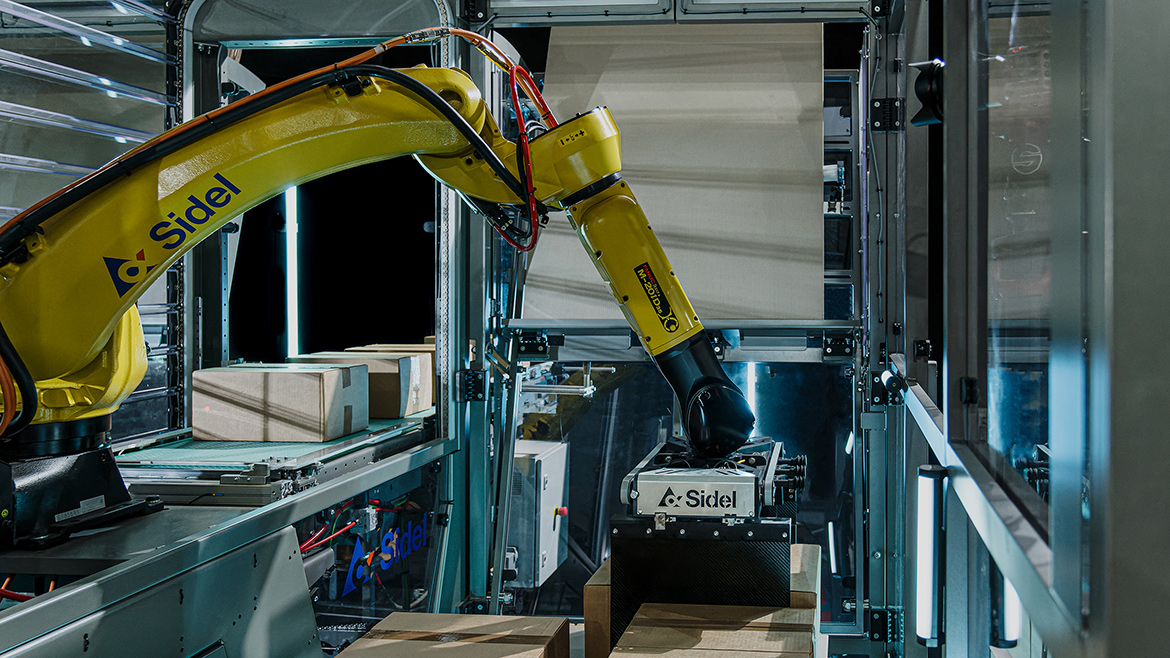Automation
End-of-line Solutions Take Center Stage
Time and again in the course of our reporting on automation and robotics, end-of-line challenges such as palletizing and case forming come to the fore.

After outgrowing its end-of-line system, Unilever's nutrition factory in Ploiesti, Romania, invested in a new central palletizing solution from Sidel. Courtesy of Sidel
Automation and robotics play an increasingly important role in the packaging industry. The applications and benefits are literally too numerous to count. That’s why we have decided in this story to shine the spotlight on some specific cases of automation and robotics serving as a game-changer for converters.
One of our favorite stories is that of Unilever’s nutrition factory in Ploiesti, Romania, outgrowing its end-of-line system to manage the breadth of brands packed at the facility. Sidel came to the rescue and installed a centralized palletizing system comprising: eight robotic cells; several hundred meters of case and pallet conveyors; four pallet-handling shuttles; and two stretch wrappers, achieving a production rate of up to 98 pallets an hour.
End-of-line automation has been a common theme in recent months. In February, Ranpak announced the development of Cut’it!™ EVO Multi-Lid, which allows up to four distinct lids to be applied in tandem with the Cut’it!™ EVO machine. This allows the management of multiple branded lid requirements through a single packaging line. We also did a podcast in February in which we talked to Ranpak’s Bryan Boatner about the critical role of end-of-line automation.
Finally, PMMI — The Association for Packaging and Processing Technologies — issued a report in late 2023 noting that labor shortages and e-commerce growth are driving warehouse automation. This insightful report looks at the extent to which CPG companies have turned to automated warehouse solutions. Automated palletizers figure prominently in this report.
Learn more about these exciting new developments in automation and robotics.
Unilever expansion sustained by Sidel’s central robotic palletizing system

From left to right: Laurentiu Badulescu, Technical Manager, Iuliana Popescu Colt, Operations Manager, and Lucian Tarida, Process Engineer, at Unilever’s nutrition factory in Ploiesti, Romania. Courtesy of Sidel

After Unilever’s nutrition factory in Ploiesti, Romania, outgrew its end-of-line system, Sidel installed a centralized palletizing system comprising: eight robotic cells; several hundred meters of case and pallet conveyors; four pallet-handling shuttles; and two stretch wrappers. Courtesy of Sidel
Unilever is one of the world’s leading FMCG companies with sales in 190 countries and products used by 3.4 billion people every day. Its nutrition factory in Ploiesti, Romania, manufactures products for one of the company’s most well-known brands, Knorr.
The entire dry nutrition portfolio includes meal makers, dish and sauce bases, and seasonings in various packaging formats – pouches, bags, cartons, and multipacks. These different product lines also handle a large variety of secondary packaging options – American boxes, tray and hood, tray and shrinking foil, and shelf-ready packaging.
Unilever Ploiesti’s production capability has gradually evolved. Volumes have tripled from 12,000 tons per year to 35,000 tons per year; SKUs have risen from 200 to 1,000; packaging lines increased from 14 to 28; and personnel has jumped from 200 to 700.
Ranpak’s Cut’it!™ EVO Multi-Lid allows four unique branded lids on a single machine

Ranpak’s Cut’it!™ EVO Multi-Lid allows four unique branded lids on a single machine. Courtesy of Ranpak
Ranpak Holdings Corp., a global leader of environmentally sustainable, paper-based packaging solutions for e-commerce and industrial supply chains, in February announced the development of Cut’it!™ EVO Multi-Lid, a solution that allows up to four distinct lids to be applied via one Cut’it!™ EVO machine, dramatically improving customer experience and managing multiple branded lid requirements through a single packaging line.
Ranpak presented its automated end-of-line (EOL) packaging solutions at LogiMAT 2024, which was held in March at the Stuttgart Trade Fair Centre.
During the show, Ranpak demonstrated its comprehensive portfolio of automated solutions, including the Cut’it!™ EVO in-line packaging machine and the Cut’it!™ EVO Multi-Lid solution. These solutions maximize packaging efficiency for customers, enabling them to achieve their goals related to compliance with the EU Packaging Directive, reaching the 40% void target required by 2030.
PMMI Report: Labor Shortages, E-Commerce Growth Are Driving Warehouse Automation

PMMI reports that CPG companies are turning to warehouse automation solutions. Sidel’s compact palletizing unit combining robotics and cobotics — the RoboAccess_Pal S — embeds three new patented features to provide an even higher level of agility, operability and compactness. Courtesy of Sidel
Labor and skills shortages are pushing consumer packaged goods (CPG) companies to invest in warehouse automation solutions, according to the Packaging and Automation in the Warehouses of the Future report produced by PMMI, The Association for Packaging and Processing Technologies.
Additionally, growing e-commerce activity and rising direct-to-consumer demands mean many CPG firms are seeing their warehousing and fulfillment operations become more complex, increasing the demand for mixed and layered pallets.
Looking for a reprint of this article?
From high-res PDFs to custom plaques, order your copy today!





.jpg?height=200&t=1740587300&width=200)
